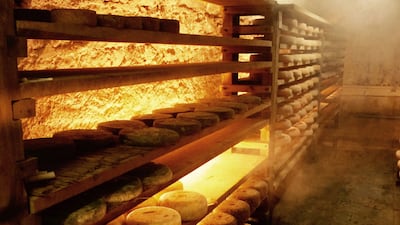If there’s one thing the French know how to do well, it’s cheese. This week, I’m touring through France learning about how cheese is made — from the cows and the milk it starts with to how it’s aged and then consumed.
France has about 2,000 different cheeses, of which 46 are PDO (protected destination of origin). That PDO designation is important when selecting cheese as it assures the cheese is high quality and produced with respect to the environment, the animals and tradition. In short, if you want to ensure what you’re eating is authentic, look for that PDO stamp.
So far this week, we’ve visited Normandy, Burgundy, Paris and Jura. We’ll visit Auvergne and Lyon by the end of the week. We’ve toured small farms and cheese production facilities to learn what it takes to get a cheese like Camembert du Normandy to your plate (I even got to milk a Normandy cow). These speciality cheeses define the regions in which they’re produced — and for good reason. The attention to detail in every aspect of production is something to be admired and applauded.
Francois Robin, one of the best cheesemongers in France — there are only 22 — has been our tour guide on the trip and says there’s no reason to be intimidated when selecting or eating cheese you’ve never tried.
“You don’t have to make a ceremony of it,” says Robin. “You just have to experiment. You may dislike a cheese and that’s OK. We all have different tastes.”
When hosting a cheese night among friends, Robin says to select a variety of cheeses ranging from mild to strong and from soft to hard. If you’re just serving cheese and not a main course, 150g of cheese per person is a good guideline. Pistachios, walnuts, almonds, hazelnuts and dried fruits such as dates and apricots will complement your cheese board perfectly. And don’t forget the baguettes. “In France, when you invite people to a cheese dinner, that means you’re a friend,” says Robin. “And it’s way easier than to cook and serve a meal.”
So skip the brunch this weekend and, instead, grab a few friends, a couple of cheese boards and a handful of French cheeses. Your taste buds will thank you for it.
Here’s a few to get you started:
Comte
This is the most consumed cheese in France. Produced in the Jura mountains, Comte is beloved by people of all ages. It’s mild and buttery, but also rich and complex.
Camembert du Normandy
This PDO soft cheese is produced from the milk of Normandy cows. Of the four million cows in France, about 500,000 are in Normandy. This cheese is made with raw cow’s milk and is smooth with small holes throughout. It has a sweet, buttery, milky flavour.
Mont D’or
This soft, creamy cheese comes in a spruce wood box. It is only produced from August 15 to March 25 and is sold between September 10 and May 10. Robin says: “This is a really good cheese. It’s creamy. It’s not that sharp. It has a milky taste with a touch of woodiness.”
Pont-L’eveque
This small square cheese comes from Normandy. It has a strong smell and is full of flavour (though the taste is milder than its smell). This cheese is smooth, creamy and rich, and works well as a dessert cheese. It pairs well with apples and roasted and fresh nuts.
Mimolette
This firm cheese is France’s answer to Edam cheese. To distinguish it from Edam, the French add annatto — a seed from the achiote tree that adds an orange colour to the cheese. This is a sweet and nutty, dry cheese that can be eaten anytime.
Roquefort
What’s a French cheese board without a little blue? This will be the strongest cheese on your board but don’t let that scare you. Some people will love it; others will hate it. But everyone should try it. Robin says, “if you want something sharp [on your cheese board], take a Roquefort.” The flavour of this creamy, tangy blue cheese will linger in your mouth long after it’s gone.
You can find PDO French cheeses in the UAE in supermarkets such as Carrefour and Waitrose as well as speciality cheese shops such as Jones the Grocer and Galeries Lafayette in the Dubai Mall.
sjohnson@thenational.ae

